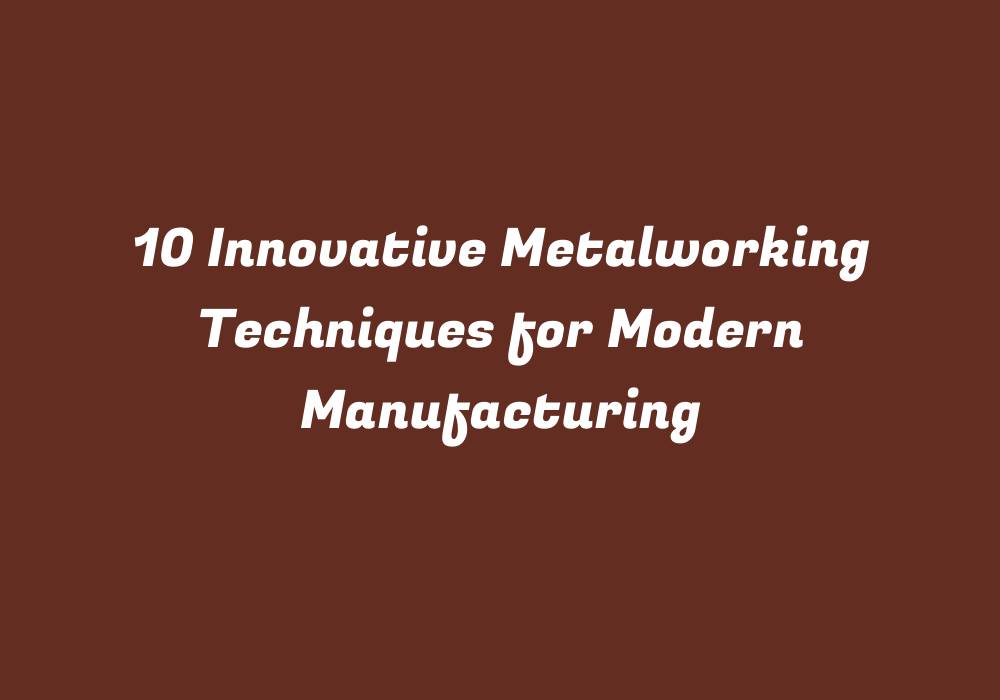Introduction to Metalworking Techniques for Modern Manufacturing
Metalworking is an essential part of modern manufacturing, enabling industries to create various products from a wide range of materials. Over time, techniques have evolved, and new approaches have emerged that can enhance the efficiency and quality of metalwork production. This article will discuss 10 innovative metalworking techniques for manufacturers in today’s industry.
Laser Cutting
Laser cutting uses a highly focused, high-intensity laser beam to cut and shape various materials such as metals, plastics, and glass. Compared to traditional methods like waterjet cutting, laser cutting offers increased precision, faster processing times, and reduced material waste. This technology is widely utilized in industries ranging from automotive to electronics manufacturing.
Electrical Discharge Machining (EDM)
In EDM, a process uses electrically charged discharges between two electrodes to cut or shape metal workpieces. This non-traditional machining method offers unique advantages like the ability to create complex shapes and eliminate the need for tooling. EDM is particularly useful in industries that require precise, intricate parts with high tolerances, such as aerospace and defense applications.
Friction Stir Welding (FSW)
Friction stir welding involves a rotating pin called a “tool” that moves along the surfaces of two pieces to be joined while generating frictional heat and mechanical forces, thus creating a weld. The process is highly automated and capable of achieving consistent results in various materials like aluminum and steel. FSW offers significant advantages over traditional welding methods by eliminating the need for filler metals or shielding gases, reducing distortion, and minimizing post-weld cleaning requirements.
Additive Manufacturing (3D Printing)
Additive manufacturing is a game-changing technology that builds 3D objects by adding layers of materials based on a digital design model. This process allows manufacturers to create complex shapes and structures without the need for tooling, molds, or machining operations. The technology has applications in diverse industries like medical, aerospace, automotive, and consumer products manufacturing, where customization and fast prototyping are essential.
Waterjet Cutting
Waterjet cutting uses high-pressure water streams to cut various materials with extreme precision and efficiency. The technology offers numerous advantages over conventional cutting techniques, including the ability to process non-metal materials and eliminate heat-related distortion in metal parts. Waterjet cutting can be utilized across a range of industries, from glass manufacturing to construction and signage production.
CNC Milling
Computer numerically controlled (CNC) milling machines are advanced computer-guided tools that can create precise 3D shapes by removing material from a workpiece. This technology is widely used for machining metal components in the automotive, aerospace, and machinery manufacturing sectors. CNC milling offers various advantages such as speed, precision, and consistent quality, making it an essential tool in modern manufacturing processes.
Laser Additive Manufacturing
Laser additive manufacturing involves using a laser beam to selectively fuse metal powder particles together layer by layer, creating complex 3D structures with high precision. This process offers numerous advantages over traditional manufacturing methods like reduced material waste and the ability to produce intricate geometries with minimal post-processing requirements. Industries such as aerospace, automotive, and medical implants have benefited greatly from laser additive manufacturing technology.
Selective Laser Melting (SLM)
Similar to laser additive manufacturing, selective laser melting is another type of metal 3D printing process that involves the selective melting of metal powders layer-by-layer using a high-energy laser beam. The technique offers several benefits like near-net shape production and minimal distortion while creating complex parts. SLM is particularly useful in the manufacturing of intricate parts or those with high precision and quality requirements, such as for medical implants and aerospace components.
Electron Beam Melting (EBM)
Electron beam melting utilizes an electron beam to melt metal powders and build complex 3D structures layer by layer. This process allows for rapid manufacturing of high-quality parts with minimal distortion and excellent surface finish. Industries like aerospace, automotive, and medical implants have embraced EBM due to its ability to produce lightweight components with high mechanical properties.
Conclusion
As metalworking continues to evolve and advance, the manufacturing industry has gained access to a variety of innovative techniques for optimizing production processes. By incorporating laser cutting, EDM, FSW, additive manufacturing, waterjet cutting, CNC milling, laser additive manufacturing, SLM, EBM, and other cutting-edge technologies into their operations, manufacturers can increase efficiency, improve product quality, reduce costs, and stay competitive in today’s rapidly changing global market.
